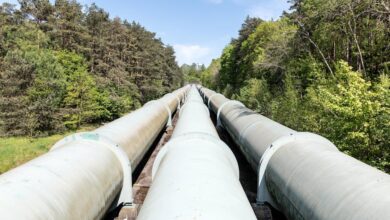Navigating the Oil Transportation Landscape: Pipelines, Tankers, and Future Innovations Impacting Global Trade and Energy Security

Oil transportation is a crucial yet often overlooked component of the global oil trade, influencing everything from oil prices to energy security. As the world continues to grapple with fluctuating oil consumption and evolving market dynamics, understanding the various methods of moving crude oil—such as pipelines, tankers, and emerging alternatives—becomes essential. This article delves into the intricate landscape of oil transportation, examining key methods and their profound impact on oil market trends. We will explore how oil pipelines and tankers shape not only the pricing of oil but also the geopolitical landscape, particularly in relation to OPEC and shale oil production. Additionally, we will look forward to future trends in oil transportation, considering innovations in technology, the environmental impact of oil logistics, and the potential for biofuels and other oil alternatives to reshape the industry. Join us as we navigate this complex and dynamic field, highlighting the importance of oil field services, oil storage, and compliance in ensuring the efficient movement of oil and natural gas across the globe.
- 1. Understanding Oil Transportation: Key Methods and Their Impact on Global Oil Trade
- 2. The Role of Pipelines and Tankers in Shaping Oil Prices and Energy Security
- 3. Future Trends in Oil Transportation: Innovations, Environmental Impact, and Alternatives to Crude Oil
1. Understanding Oil Transportation: Key Methods and Their Impact on Global Oil Trade
Oil transportation plays a pivotal role in the global oil trade, connecting producers to consumers while influencing oil market trends and prices. Understanding the key methods of oil transportation is essential for grasping their impact on energy security and the overall dynamics of the oil industry.
Pipelines are one of the most common and efficient methods for transporting crude oil and natural gas. They facilitate the movement of oil from production sites, such as shale oil fields and offshore drilling platforms, to refineries and storage facilities. As a result, pipelines significantly affect oil supply chains and the availability of oil for consumption. The stability of oil prices can often be traced back to pipeline infrastructure, as disruptions can lead to supply shortages and increased costs.
Tankers are another critical component of oil transportation, particularly for moving oil over long distances across oceans. These vessels transport crude oil from regions with abundant oil reserves, like the Middle East and Canada’s oil sands, to refining centers around the globe. The efficiency of tanker operations directly influences the global oil trade, as any disruptions—whether due to geopolitical tensions or environmental regulations—can have immediate repercussions on oil prices.
In addition to pipelines and tankers, other methods, such as rail and truck transportation, are also utilized, particularly in regions where pipeline infrastructure is lacking. However, these methods often involve higher costs and potential delays, thereby affecting the overall efficiency of oil logistics.
The environmental impact of oil transportation cannot be overlooked. Incidents such as oil spills can have devastating effects on marine and terrestrial ecosystems, leading to stricter regulations and compliance requirements for oil companies. This has prompted the industry to explore alternative methods and technologies, including biofuels and other oil alternatives, to reduce its carbon footprint and mitigate the impact on the environment.
As the world moves towards more sustainable energy solutions, the future of oil transportation will likely involve a shift in focus from traditional methods to innovative technologies that enhance energy security while addressing environmental concerns. Investors in the oil sector must stay informed about these trends, including oil price hedging strategies and the implications of regulatory changes on the oil refining and petrochemicals sectors.
In conclusion, understanding the various methods of oil transportation is crucial for navigating the complexities of the oil market. As global oil consumption continues to evolve, so too will the strategies for transporting this vital resource, shaping the future landscape of oil geopolitics and the energy market at large.
2. The Role of Pipelines and Tankers in Shaping Oil Prices and Energy Security
The transportation of oil through pipelines and tankers plays a critical role in shaping oil prices and ensuring energy security across the globe. Pipelines serve as the backbone of the oil supply chain, facilitating the efficient movement of crude oil from production sites to refineries and storage facilities. This infrastructure is essential for maintaining a steady flow of oil to meet global consumption demands, directly influencing oil market trends and prices.
Tankers, on the other hand, are pivotal for transporting oil across oceans and waterways, enabling international trade in crude oil and refined products. The flexibility and scale of maritime transport help countries access oil reserves that may not be geographically close, allowing for diversification of supply sources and enhancing energy security. This is particularly significant in a landscape where geopolitical tensions can disrupt supply chains, making robust oil transportation systems crucial for stabilizing oil prices.
The dynamics between pipelines and tankers also reflect the ongoing evolution of the oil industry, including the rise of shale oil production in the United States and the increasing reliance on offshore drilling. These developments have prompted OPEC and other oil-producing nations to adapt their strategies, impacting the global oil trade and pricing models. Additionally, the interplay between supply and demand can lead to fluctuations in oil prices, making it essential for investors to engage in oil price hedging to protect against volatility.
While the transportation of oil is vital for economic stability, it is not without its challenges. The environmental impact of oil transportation methods, particularly in terms of spills and emissions, has spurred discussions on oil alternatives such as biofuels and natural gas. As the industry evolves, the adoption of new oil technologies and stricter oil regulations will be crucial in ensuring compliance and minimizing the environmental footprint of oil operations.
In summary, pipelines and tankers are not just modes of oil transportation; they are integral to the functioning of the global oil market. Their influence extends beyond logistics, affecting oil prices, energy security, and the broader discussions around sustainable practices in oil consumption and production. As the world continues to navigate the complexities of oil geopolitics and the transition towards cleaner energy sources, the role of oil transportation will remain a focal point in the ongoing dialogue surrounding energy security and economic resilience.
3. Future Trends in Oil Transportation: Innovations, Environmental Impact, and Alternatives to Crude Oil
As the global oil market continues to evolve, several future trends in oil transportation are emerging, driven by innovations in technology, growing environmental concerns, and the search for alternatives to crude oil.
One of the most significant innovations is the development of advanced oil transportation technologies. These include enhanced pipeline systems equipped with smart sensors to monitor flow rates and detect leaks, which can improve the safety and efficiency of oil supply chains. Furthermore, the integration of automated tankers and drones for monitoring offshore drilling operations is set to revolutionize the logistics of oil transportation, thus reducing operational costs and increasing energy security.
The environmental impact of oil transportation is another critical consideration. As the world grapples with climate change, there is increasing pressure on the oil industry to reduce its carbon footprint. This has led to stricter oil regulation and compliance measures aimed at minimizing spills and other environmental hazards associated with oil refining and transportation. The shift towards more sustainable practices is prompting the exploration of biofuels and other oil alternatives, which could significantly alter the landscape of oil consumption and production.
In addition to these innovations, the global oil trade is witnessing a rise in interest in shale oil and oil sands, particularly in North America. These resources, while controversial due to their environmental impact, are reshaping oil market trends and altering the dynamics of oil geopolitics. The OPEC alliance is also responding to these changes, adapting its strategies in light of fluctuating oil prices and the growing influence of countries with substantial oil reserves.
Moreover, the demand for natural gas as a cleaner alternative to crude oil is increasing, leading to potential shifts in oil transportation methods. Oil field services are evolving to accommodate this demand, with companies investing in technologies that support the dual transportation of oil and natural gas.
As oil prices fluctuate and the world transitions toward more sustainable energy solutions, the future of oil transportation will likely involve a combination of traditional methods and innovative technologies. By embracing these changes, the industry can navigate the complexities of oil price hedging and ensure a more secure and environmentally responsible energy future.
References:
– International Energy Agency. (2023). World Energy Outlook 2023. Retrieved from https://www.iea.org/reports/world-energy-outlook-2023
– U.S. Energy Information Administration. (2023). Petroleum & Other Liquids. Retrieved from https://www.eia.gov/petroleum/
– World Oil. (2023). The Future of Oil Transportation. Retrieved from https://www.worldoil.com/news/category/2023/the-future-of-oil-transportation
In conclusion, oil transportation remains a critical component of the global oil trade, influencing everything from oil prices to energy security. The methods of transporting crude oil—whether through pipelines, tankers, or emerging alternatives—play a pivotal role in shaping the dynamics of the oil market. As we navigate the complexities of oil geopolitics and the fluctuating demands of oil consumption, understanding these transportation methods becomes essential for stakeholders in the oil sector.
Looking ahead, the industry is witnessing significant innovations aimed at enhancing efficiency while addressing the environmental impact of oil. The shift towards biofuels and other oil alternatives is not only a response to the pressing need for sustainability but also an opportunity for oil investors to explore new avenues in the evolving energy landscape. As OPEC adjusts its strategies in light of shale oil production and offshore drilling advancements, the future of oil transportation will undoubtedly continue to adapt.
With the rise of oil technologies and regulatory compliance measures, stakeholders must remain vigilant in monitoring oil market trends and the implications for oil price hedging. By embracing these changes, the industry can ensure the stability of oil supply chains and the longevity of our oil reserves while promoting a more sustainable future for all. Continuing to invest in innovative oil field services and downstream oil processes will be crucial in meeting the energy demands of tomorrow.





